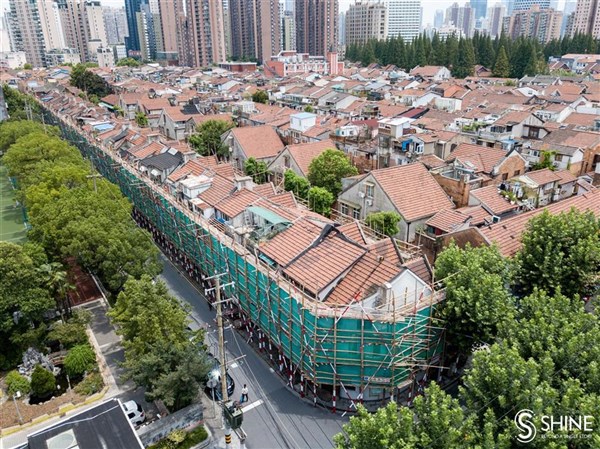Shanghai Today
Century-old shikumen community gets historic facelift - August 07, 2020
虹口百年石库门老弄堂启动修缮

Yan Yumei remembers the glory days of the Hengfengli community, when she got married in the traditional neighborhood in downtown Hongkou District three decades ago.
The rows of shikumen, Shanghai’s unique stone-gate buildings, on Shanyin Road were built around the 1920s and most residents then were intellectuals and successful businessmen, Yan said.
“The region around Shanyin Road was once an affluent community, with many celebrities living nearby,” Yan recalled.
The neighborhood is now receiving its biggest facelift, which aims to restore its historic appearance while improving the living conditions of residents.
“I’m looking forward to the facelift to revive the glory of the area,” she added. The brick-and-wood structures have become out-of-date, and living space is cramped by an increasing number of inhabitants.
Yet, Shanyin Road is considered an “open-air museum” of the city’s old residences.
The first road built in Hongkou in 1911 (formerly known as Scott Road) features houses and villas in English, Japanese and shikumen styles.
The street was once home to literati and revolutionaries, including writers Lu Xun (1881-1936) and Mao Dun (1896-1931). It also housed Qu Qiubai (1899-1935), a leader of the Communist Party of China in the late 1920s, and Zeng Liansong (1917-1999), designer of China’s national flag.
Hengfengli at Lanes 69 and 85 of Shanyin Road has nearly 100 three-story shikumen houses, which are listed as the city’s heritage structures.
The liaison office of the headquarters of the third uprising of local workers in 1927, led by the Communist Party of China against warlords occupying Shanghai, was based there. The Party School of Central Committee of CPC and the CPC Jiangsu Province Committee were also once set up in the neighborhood.
The renovation, scheduled to be completed by the end of the year, will mainly repair exterior walls, rooftops and supporting structures.
Wooden pillars and mortise-and-tenon supports have become decayed or broken; these will be fixed based on original blueprints during the project.
Some shared kitchens and toilets, as well as public areas, will be renovated to improve the living conditions of residents, according to the Hongkou District government.
To restore the historical ambiance of the traditional community, the project will replace the aluminum alloy windows on the ground floor with wooden windows.
Renovations will involve use of unique "water-washed stones" and "fair-faced bricks" that increase wall waterproofing while preserving the historical look.
The concrete paths within the neighborhood will also be restored to original brick tiles.
Yan lives in a three-story apartment building, one of the best-preserved in the community. Other buildings are usually shared by multiple inhabitants. The house was purchased by her husband’s grandmother and the original decor has been kept.
“It's a dilemma for us to keep preserving our ancestor’s heritage, or improve our living condition with a thorough renovation,” Yan said. Some of her neighbors have launched major redecorations and their homes look far better than modern residential apartments, according to Yan.
The ongoing facelift will partially solve her problem — the creaking stairs and floors will be stabilized and the house will look beautiful from the outside, Yan said.
Every year she invites family members, who used to live together in the building, for a banquet on the Chinese New Year's Eve.
“I’m looking forward to the family reunion next year when the house has a brand-new look,” Yan said.
“Many residents hope to get relocated by the government, but I would rather stay in the traditional community where I can talk with old neighbors and take part in various community activities,” Yan said.
She joined the COVID-19 prevention volunteer team organized by the neighborhood committee in February and checked temperatures and made registrations for the residents at the entrance for over four months.
She also has strong emotional bonds with the many time-honored brands and eateries on Shanyin Road and Sichuan Road N., such as the West Lake Restaurant, Sixin Dumpling, Wanshouzhai Small Steamed Buns and a small mutton restaurant. They are also about to be renovated to restore their former popularity.
Application Status
| 04-16 | 21315227 | Processing |
| 03-12 | 21315226 | Processing |
| 09-26 | 21315225 | Processing |
Inquiry Status
| 02-29 | 02131558 | Received |
| 03-06 | 02131557 | Received |
| 11-14 | 02131556 | Received |
FAQ
Q: Q: Is there a place where I can get...
A: A: Log on to http://touch.shio.gov....
A: A: Log on to http://touch.shio.gov....
Q: Q: What is the easiest way to set u...
A: A: 1. Log on to http://touch.shio.g...
A: A: 1. Log on to http://touch.shio.g...
Q: Where can I get an English map of S...
A: English maps of Shanghai are availa...
A: English maps of Shanghai are availa...

